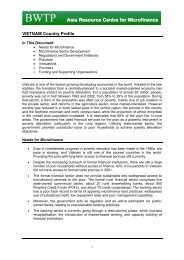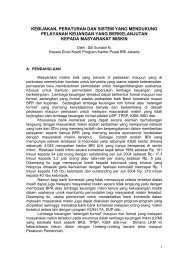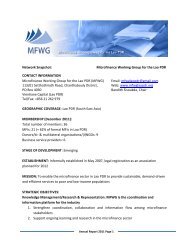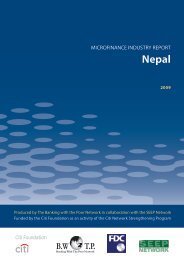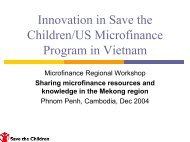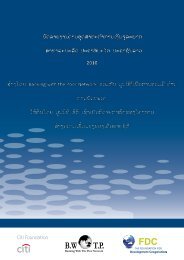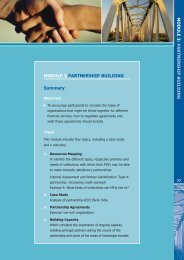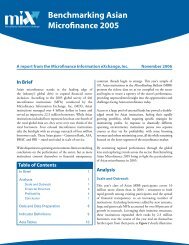MICROFINANCE INDUSTRY REPORT Thailand - Banking with the ...
MICROFINANCE INDUSTRY REPORT Thailand - Banking with the ...
MICROFINANCE INDUSTRY REPORT Thailand - Banking with the ...
You also want an ePaper? Increase the reach of your titles
YUMPU automatically turns print PDFs into web optimized ePapers that Google loves.
3. Challenges and OpportunitiesCurrently, <strong>the</strong>re are still a few constraints forMFIs in <strong>Thailand</strong>. However, it is hoped that <strong>the</strong>implementation of new Microfinance Master Planshould ease many of <strong>the</strong>se constraints and openup more opportunities for <strong>the</strong> new players. The keyconstraints are as follows:i. Subsidised creditsThe above discussion reveals that access tosubsidised low interest rate credits for <strong>the</strong> poorremains a problem in <strong>Thailand</strong>, but is different frommany o<strong>the</strong>r countries. The problem is chiefly <strong>the</strong>proliferation of too much subsidised credit frommultiple sources. Such credit is often used for nonincomegenerating items and activities, which leadsto an inability to pay existing debts. Therefore overindebtednessoften results from poor clients seekingnew and more loans, and most of <strong>the</strong> time, <strong>with</strong>higher interest rate from private money lenders, torepay <strong>the</strong>ir earlier debts. Thus, this leads to deeperindebtedness as <strong>the</strong> cycle would continue.To make things worse, apart from injecting moresubsidised lower interest loans for <strong>the</strong> poor, <strong>the</strong>Thai government helped to lift <strong>the</strong>se overwhelmeddebt problems of <strong>the</strong> poor by introduced debtrestructuring, a debt moratorium, and debtforgiving programs. These are very sensitive anddelicate tools to apply in microfinance, because<strong>the</strong>y send <strong>the</strong> wrong signal to poor borrowersthat deferring payments on <strong>the</strong>ir loans or evendefaulting are acceptable practices.From <strong>the</strong> microfinance perspective, <strong>the</strong> practices of<strong>the</strong> Thai government are considered to be unfair too<strong>the</strong>r MFIs and are unconducive to promoting anattractive environment for o<strong>the</strong>rs players to enterinto this market. Such practices are also hindering<strong>the</strong> growth of <strong>the</strong> microfinance sector in <strong>Thailand</strong>.The Thai government should <strong>the</strong>refore reconsider<strong>the</strong> broad impact of such policies, which canhamper both poor borrowers <strong>the</strong>mselves and <strong>the</strong>microfinance industry as a whole.ii. Sustainable interest ratesInterest rates charged by most semi-formal MFIs in<strong>Thailand</strong> span a wide range; from 10 percent to 24percent per annum. Although <strong>the</strong> BOT had lifted allinterest rate ceilings for formal financial institutionsin 1992, it still stipulates a 15 percent per annuminterest rate on personal loans from NBFIs andprivate individuals, capped at 28 percent per annuminclusive of all related fees. For credit card services,banks usually charge additional penalty interest onlate payment, which increases <strong>the</strong> total interest rateto <strong>the</strong> maximum level of personal loans. As such,<strong>Thailand</strong> is likely to be one of <strong>the</strong> very few countries,if not <strong>the</strong> only country, where interest rates chargedby MFIs are lower than banks.Because of high competition from subsidised lowinterest rate credits provided by <strong>the</strong> government,it is difficult for non-government MFIs to increase<strong>the</strong>ir credit interest to a sustainable rate. It is hopedthat soon-to-be implemented regulations will openup <strong>the</strong> microfinance market and <strong>the</strong> governmentwill assume a more regulatory role and level <strong>the</strong>playing field in order to attract more investors andplayers into <strong>the</strong> country’s microfinance industry.iii. Reliable informationInformation asymmetry has been one of <strong>the</strong> keyconstraints in microfinance industry around <strong>the</strong>world. It is common practice for borrowers toseek loans from multiple sources. But <strong>the</strong> lack ofappropriate market and customer credit informationin <strong>the</strong> microfinance business makes it difficult foran MFI to determine whe<strong>the</strong>r a loan applicantalready has a loan outstanding <strong>with</strong> o<strong>the</strong>r financialprovider(s), or whe<strong>the</strong>r he/she is blacklisted for badrepayment records or defaulted on prior loans.There is, however, some hope in this regard.The BOT is considering, as part of <strong>the</strong> upcomingMicrofinance Master Plan, to set up a separatemicrofinance credit bureau in conjunction to<strong>the</strong> current existing credit bureau office. Even ifthis occurs, it is expected several years would berequired for any microfinance credit bureau tobecome fully functional.<strong>Banking</strong> With The Poor Network 19



